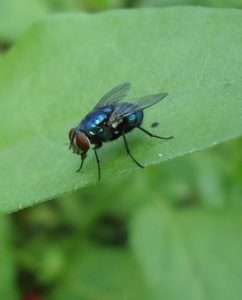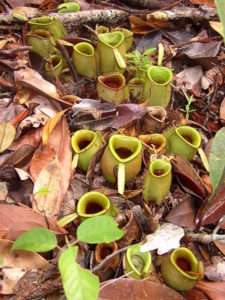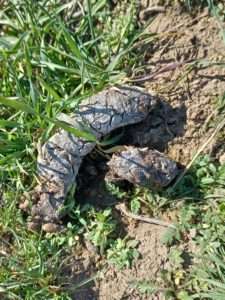Think back to biology classes you’ve taken and you very likely heard the terms carnivore (animal that eats meat), herbivore (animal that eats plants), and omnivore (animal that eats meat and plants). You also likely got an overview of the food web and how energy passes from one living being to another through what they eat or are eaten by. Depending on your science curriculum, you might even heard the term “detritivores”. Or you might not, and therefore be wondering “Okay, I remember the carnivores and herbivores and stuff, but what ARE detritivores?”
A Messy Meal Indeed
 Detritivores are, in short, beings that eat decaying matter. Unlike decomposers, which I’ll discuss next week, detritivores have to actually consume the rotting stuff rather than simply absorbing the nutrients into themselves. So you have a bunch of beings that subsist partly or entirely not just on dead and decaying animals, plants, and fungi, but in some cases also eat fecal matter and other waste. Not exactly appetizing in our eyes, but hey, it’s a living.
Detritivores are, in short, beings that eat decaying matter. Unlike decomposers, which I’ll discuss next week, detritivores have to actually consume the rotting stuff rather than simply absorbing the nutrients into themselves. So you have a bunch of beings that subsist partly or entirely not just on dead and decaying animals, plants, and fungi, but in some cases also eat fecal matter and other waste. Not exactly appetizing in our eyes, but hey, it’s a living.
You’ve almost certainly run into some detritivores in your everyday life. Worms are a very good example; various sorts of earthworms and other terrestrial annelids chow down on decaying matter. On the surface of the land, snails and slugs also often include detritus in their diet, as do some flies, and most millipedes with their many (though not quite a thousand) legs. The springtails that I talked about in my article about moss last month include some detritivorous species. Termites evolved to break down dead wood, and while we often are annoyed by female mosquitoes that bite us to draw blood during their egg-laying season, the majority of mosquitoes are detritivores, eating decaying matter in and around water. And roly-polies and other woodlice spend a good bit of their day finding decaying matter to eat. Perhaps one of the most infamous detritivores is the dung beetle, which not only eats fecal matter but rolls up big spheres of it to lay eggs in so their young get off to a good (for them) start.
If you live near the ocean, know that you also have some detritivorous animals in the water, too! Some starfish species will eat detritus, and fiddler crabs will look for decaying matter in the water and on shore. Sea cucumbers are also consumers of refuse, picking up food with their foot-like tentacles, or simply allowing the water currents to bring them something to eat. Freshwater lakes, streams and other places have a variety of detritivores, too, from bottom-feeding fish that “vacuum” the floor, to a whole host of insects and other invertebrates picking up miniscule bits of waste.
 While plants are generally not detritivores, instead benefiting from the actions of detritivorous animals and decomposers like fungi, one notable exception is Nepenthes ampullaria. Most pitcher plants in the genus Nepenthes are carnivores, enticing insects and other small animals to fall into their partly-filled pitcher and drown, so they can then digest them. However, N. ampullaria has broadened its diet and also uses its pitcher to collect and break down any plant matter that falls in, like dead leaves.
While plants are generally not detritivores, instead benefiting from the actions of detritivorous animals and decomposers like fungi, one notable exception is Nepenthes ampullaria. Most pitcher plants in the genus Nepenthes are carnivores, enticing insects and other small animals to fall into their partly-filled pitcher and drown, so they can then digest them. However, N. ampullaria has broadened its diet and also uses its pitcher to collect and break down any plant matter that falls in, like dead leaves.
What Are Detritivores Good For?
We may think that detritivores’ diets are gross, and be happy to leave them to it. But it’s not just a matter of them not being able to catch live prey or graze on green plants. Instead, these beings have exploited a particular niche that allows them to take advantage of the nutrients and energy within the sorts of decaying matter that most others won’t touch. The natural world is quite efficient, and there is no resource that is not eventually used by someone, somewhere.
 Imagine if we didn’t have detritivores. It would be like a society without sanitation workers–smelly, filthy, and more hazardous to our health. While decomposers are certainly able to do their work, it can take them longer, especially when dealing with larger amounts of waste. Detritivores do a lot of the initial heavy lifting when it comes to breaking down detritus, leaving the decomposers with smaller or finer material to work with. Some may carry smaller decomposers like bacteria from food source to food source, further helping to clean up the mess.
Imagine if we didn’t have detritivores. It would be like a society without sanitation workers–smelly, filthy, and more hazardous to our health. While decomposers are certainly able to do their work, it can take them longer, especially when dealing with larger amounts of waste. Detritivores do a lot of the initial heavy lifting when it comes to breaking down detritus, leaving the decomposers with smaller or finer material to work with. Some may carry smaller decomposers like bacteria from food source to food source, further helping to clean up the mess.
Want to help your local detritivores? Leave them something to eat! If you have a yard, create a compost heap or bin, and pile leaves and other yard debris up in a corner rather than bagging them up to be thrown into a landfill. If you’re on a farm, you can also create a manure pile, which will not only feed some of your local detritivores, but also make a nice addition to a garden after a while. Leave dead trees (standing or falling) as long as they aren’t causing a direct hazard to anyone, and not only will you have a happy community of detritivores, but woodpeckers and other birds.
That’s right! Your local detritivores aren’t only helpful in what they eat, but in what they feed. Larger forms of wildlife like birds, salamanders, frogs, snakes, and other animals include worms, slugs, flies and other detritivores in their diet. The more biodiversity you have in your area, the healthier your local ecosystems are. Feeding the detritivores may not be as romantic as feeding the birds, but it is arguably even more ecologically valuable. (And your local birds will thank you, too!)
